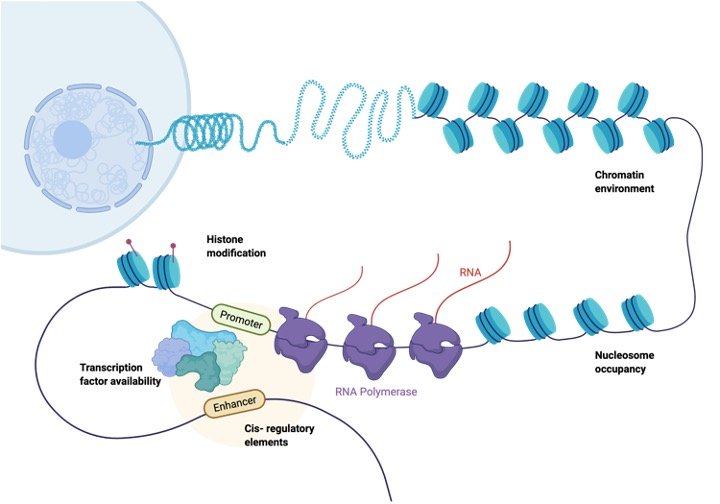Category: Study Materials
-

Phylum Chordata: Definition, Characteristics, & Examples
Continue ReadingPhylum Chordata Definition
Chordate belong to the phylum Chordata that comes under the Deuterostomes kingdom that is characterized by the development of the anus that precedes the development of the mouth in the embryonic stage.
Chordata phylum comprises a large variety of organisms including invertebrates that lack a backbone and vertebrates that possess a backbone. This phylum includes 3 subphyla that are Urochordata, Cephalochordate, and Vertebrata. They generally have a bilaterally symmetrical shape though exceptions are there.
Phylum Chordata Characteristics
The following characteristics are exhibited by all the organisms that come under this phylum at some stage of their lives or during embryonic development.
Pharyngeal Slit: This can also be seen in invertebrates where they function in filter-feeding. Whereas in vertebrate fishes they develop into gill arches the function that supports gills. In other vertebrates like humans, these gill slits can only be seen in the embryonic stage and disappear later in development. This tissue may develop into eustachian tubes or jaws in terrestrial vertebrates.
Dorsal Hollow Nerve Cord: This dorsal hollow tube comprises nerve fibers that will develop into the CNS that consists of the brain and spinal cord. The vertebral column shields this nerve cord. The vertebral column consists of bones that form our backbone. Whereas in non-chordates the nerve cords are located either laterally or ventrally and are solid.
Notochord: This skeletal flexible rod is made of cartilage and functions to support the structural frame of the organism. It is present between the nerve cord and the digestive tube. The phylum derives its name from this rod. In vertebrates, it is the precursor of the spine or backbone.
Post-Anal Tail: This posterior elongation provides balance, helps the aquatic organisms in propelling themselves in water, and is utilized by certain terrestrial vertebrates in signaling or in finding a mate. This tail disintegrates as it shrinks and can be seen as a tailbone during embryonic development in apes and humans.
Chordata Subphylum
Vertebrata: This subphylum is also known as Craniata as the comprising organisms have a cranium case that protects their head and is known as a skull. They are also distinguished by the presence of a closed circulatory system, unique motor and sensory cranial nerves, internal organs, and a highly evolved brain. This subphylum includes amphibians, fish, mammals, reptiles, and birds. Their evolution can be studied using paleontological pieces of evidence like fossils as due to the presence of cartilage and bone, their remains were preserved.
Cephalochordata: Also called lancelets this subphylum comprises marine filter-feeding organisms. These have segmented small elongated and soft bodies due to which they did not fossilize well. They bury themselves in substrates and are seen in soft bottoms with exposed head regions consisting of tentacles that help in capturing the prey. Though they resemble fish, they do not have a brain, limbs, scales, and backbone like them. They have a greater number of pharyngeal slits than the fish.
Urochordata: This sub-phylum is also referred to as Tunicates and comprises sea salps and squirts. They are also soft-bodied organisms and thus their fossils are rare. These marine organisms are barrel-shaped filter feeders that are not segmented. The tail can be seen in the larval stage when it is free-living. But in adults, they lose the tail and attach to a substrate. In adults, the only chordate characteristic visible is the pharyngeal slits.
Phylum Chordata Examples
Lampreys: Belonging to subphylum vertebrates this chordate is a filter feeder during its larval stage. The adult of this jawless fish is a parasite that latches on to other fish with its oral disk that comprises teeth. They are not obligate parasites and the adults may live off the reserve they built in the larval stage. The adult exhibits external gills, nerve cord, cartilaginous skeleton, and a notochord. In the larval stage, they utilize a mucus-secreting organ that helps to trap the food in their pharynx and also show a post-anal tail.
Sea Squirts: This barrel-shaped organism belongs to the subphylum Tunicates. The larval stage resembles a tadpole and has a dorsal nerve, post-anal tail, notochord, and pharyngeal slits. In their adult stage, they are primarily filter feeders that have 2 siphons that are openings that are employed to draw water during filter feeding. They acquire their food phytoplankton by this method and drain the excess water through the other siphon.
Phylum Chordata Citations
Share
Similar Post:
-

Sexual Reproduction: Definition, Types, & Examples
Continue ReadingSexual Reproduction Definition
Sexual Reproduction defines the process through which organisms produce progeny that has variations as a result of the recombination process involved in gamete formation. Two individuals of different sexes contribute as parents, create new offspring by combining their genetic information.
This genetic information is present within the chromosomes that are present in the organelle nucleus of sex cells known as gametes. The gametes produced by the male are known as sperm while those produced by the female are known as egg or ovum.
During the process of sexual reproduction, the syngamy of these gametes leads to the production of a zygote that later develops into an embryo. This embryo has half its genomic content from one parent and the other half from the other.
For instance, in the case of humans, 46 chromosomes are present in an individual out of which 23 are from its father and the other 23 from its mother. The result is an organism that is not a clone of either of its parents but resembles both of them.
Sexual Reproduction and Fertilization
During this process, traits are passed down to the progeny. These traits include phenotypic traits that are required for adapting to their environment and thus directly influence their survival and genotypic traits like resistance etc. The genes responsible for these traits undergo selective pressures according to the environment they live in.
This evolutionary process of natural selection helps in the survival of individuals with favorable traits and these then reproduce. Sexual reproduction aids in increasing diversity or variation that works as the raw material for different evolutionary processes like natural selection. It differs remarkedly from asexual reproduction where only one parent is involved.
There is no syngamy in asexual reproduction and as a result, the offspring are the exact clones of their parent. This kind of reproduction can be seen in certain organisms like fungi, bacteria, corals, starfish, hydras, and plants like strawberries.
Types of Sexual Reproduction
i. Allogamy
Allogamy refers to the syngamy where the involved gametes are from 2 different individuals. Ovum or egg is the female gamete while sperm is the male gamete. These are specialized sex cells that are structured in a manner that enhances fertilization probability.
These cells are haploid and consist of 23 chromosomes in humans. When they fuse they form a diploid zygote that then undergoes mitosis to form an embryo. Mitosis is a type of cell division seen in cells after they have successfully replicated their DNA.
Animals have courtship rituals that help them to breed with an organism that will reproduce to produce fertile progeny that has genes that increase their fitness and survivability. The desirable traits include aggression, speed, good health, agility, etc.
As a result of sexual reproduction, phenotypic and genotypic variations can be seen. Based on these variations, the organisms choose their mate that exhibits the desirable phenotypic traits. These variations also increase competition as a result only the best animal that shows desirable traits are chosen and this is known as sexual selection.
This also leads to sexual dimorphism, wherein different sexes are distinct morphologically. The males are generally brightly colored and often have exaggerated body parts that help them to attract a mate. Whereas the females are camouflaged with dull colors as they are primary caretakers of their offspring.
But often these sexually selected traits may also affect the survivability of a species. For instance, bright coloration not only attracts potential mates but also predators. But these traits do persist in populations where mating is essential.
a. Internal Fertilization
This occurs within one of the parent’s bodies, where the gametes meet and fuse often via sexual intercourse. It generally happens in the female body, but rarely this can also be observed in the case of seahorses. In seahorse, the female will implant her gametes into the male where the fusion will occur. The further steps of this process are species-specific.
In some organisms like reptiles, insects, and birds, they may lay fertilized eggs, wherein the rest of development occurs. These eggs also contain yolk that helps to nourish the embryo. After a certain period, the developed young ones will hatch. This is referred to as oviparity. In the case of mammalian species, the embryo grows inside the body of their mother, and the baby is born live and this is known as viviparity.
In placental mammals the embryos are supported by the placenta, which helps to provide the embryo with nutrition, is also involved in thermoregulation, and also removes the waste products. While in marsupial offspring like a koala is removed from inside the mother’s body after completing a brief gestation period.
They then complete their development in an external pouch present in front of their mother’s body. Ovoviviparity represents a third type of development whereby the embryos grow and develop in eggs within the parent’s body and ultimately hatch inside and thus giving the appearance of live birth.
b. External Fertilization
Here the syngamy or fusion of gametes occurs outside the body of the parents. Most invertebrates, amphibians, and fish employ this method, where a large number of gametes are released synchronously in proximity from both the parents.
This quick release of the gametes into an aquatic medium is referred to as spawning. The females can also lay an egg on a substrate where the males will also release their gametes. These gametes have specialized adaptations for movement like the presence of strong flagella.
ii. Autogamy
Here the female and male gametes that fuse are produced by a single individual. These species that can produce gametes of both sexes are known as hermaphrodites. It is similar to asexual reproduction, in the aspect that only 1 parent is involved, but unlike asexual reproduction the progeny produced have variations resulting from the recombination of chromosomes from the male and female gametes. Animals that reproduce by allogamy include earthworms and plants. Reproduction between hermaphrodites is possible and can in this case increase genetic diversity.
Advantages of Sexual Reproduction
Mitosis can result in accumulation of some harmful deleterious mutations over time. Sexual reproduction only allows a fraction of these harmful genes to be passed in the progeny unlike asexual reproduction. This leads to an increase in fitness that also increases their survivability.
This is further increased by natural selection, that eventually eliminates these genes from the population. More genetic variations helps to increase the adaptability of an organism to its environment through selection. Some mutations that are of no present use may prove beneficial in the future circumstances. This also acts as the driving force for speciation.
Sexual Reproduction Citations
- Thyroid hormones and female reproduction. Biol Reprod . 2018 Nov 1;99(5):907-921.
- Bisphenols in the pathology of reproduction. Ceska Gynekol . Winter 2019;84(2):161-165.
- Role of oxidative stress in female reproduction. Reprod Biol Endocrinol . 2005 Jul 14;3:28.
Share
Similar Post:
-

Heterochromatin: Definition, Types, & Examples
Continue ReadingHeterochromatin Definition
Heterochromatin is the densely packed region of chromatin that impairs the transcription of that particular section of DNA. Euchromatin unlike heterochromatin is lightly packed and genes that are actively transcribed are located in this region.
Chromatin comprises DNA and proteins that bind DNA and stabilize it and it is located in the nucleus in the case of eukaryotes. In its condensed state heterochromatin restricts RNA and DNA polymerases to access the DNA strand and thus, it inhibits both DNA transcription and replication. Heterochromatin is of 2 types facultative and constructive heterochromatin. Heterochromatin constitutes only less than 10% of chromatin in humans.
Heterochromatin Structure
The DNA is present as chromatin that is the complex of proteins and DNA in eukaryotes. The proteins involved in this complex are known as histones that wrap the DNA around them. Approximately 200 bp DNA is wrapped around each histone to form nucleosomes which are sets of 8 histones.
Histones present in nucleosomes are H23, H2A, H4, and H3. Their 2 copies each are present in the nucleosome that form an octamer. Nucleosomes are connected by linker DNA that is strands of DNA connecting both nucleosomes.

This structure of chromatin that is loosely packed is referred to as the beads-on-string model. The beads represent nucleosomes and the string denotes DNA. It depicts how the nucleosomes are connected by DNA comprising chromatin.
Heterochromatin represents the second level of packaging of DNA into a 30-nm condensed fiber that is helically coiled and whose diameter measures 30nm. This type of heterochromatin is more easily visible in G-banding as it is a more tightly condensed form.
The 30 nm fiber structure can be further compacted and condensed into chromosomes and further condensation leads to the formation of metaphase chromosomes.
A double-strand DNA helix is wrapped around an octamer of histones that form nucleosomes to constitute beads on the string structure of euchromatin. It can be further compacted into heterochromatin that comprises 30 nm fiber. Finally, this can be compacted into chromosomes and metaphase chromosomes.
DNA is in the heterochromatin conformation when it is transcriptionally repressed was the polymerases and other regulatory proteins cannot bind to it in this conformation. The linker DNA in euchromatin is available for transcription, while in heterochromatin conformation it is coiled around nucleosomes and is not exposed.
Heterochromatin Types
There are two Types of Heterochromatin: Constitutive and Facultative
Besides the 2 major types of heterochromatin, there are other kinds that intermediate features of facultative and constitutive heterochromatin.
Constitutive heterochromatin stays in heterochromatin configuration and is more stable and often comprises repeated DNA sequences known as satellite DNA. For instance, this kind of heterochromatin is present in telomeres and centromeres that have structural roles.
Facultative heterochromatin is reversible and can change its structure based on the cell cycle stage. It also consists of repeated sequences of DNA called LINE sequences. For example, the Barr body is the inactivated X chromosomes.
Heterochromatin, Cell Cycle, and Gene Expression
DNA packaging level correlates with cell cycle stages. DNA exists in euchromatin form when it either needs to be transcribed or replicated. When the genes in the DNA do not need to be transcribed or replicated then it exists in heterochromatin conformation.
DNA exists in transcriptionally active forms during the interphase stage, while it is present in metaphase chromosome form in mitosis or meiosis stage when the cell is dividing. Thus by regulating DNA conformation or packaging, gene expression can be controlled.
Housekeeping genes are usually present in the euchromatin region as they need to be constitutively expressed as they are involved in metabolic reactions that sustain the cell. The genes that are not actively expressed occur in heterochromatin configuration. This type of gene regulation is achieved by histone tail modifications.
Acetylation or methylation of histone tails can determine the state the DNA exists in. For example, hypoacetylation on the histone tail will repress DNA expression and change the conformation to heterochromatin.
Heterochromatin Citations
- Role of H3K9me3 heterochromatin in cell identity establishment and maintenance. Curr Opin Genet Dev . 2019 Apr;55:1-10.
- Establishment and evolution of heterochromatin. Ann N Y Acad Sci . 2020 Sep;1476(1):59-77.
- Ten principles of heterochromatin formation and function. Nat Rev Mol Cell Biol . 2018 Apr;19(4):229-244.
- Image are created with BioRender.com
Share
Similar Post:
-

Turgid: Definition, Types, & Examples
Continue ReadingTurgid Definition
Turgid refers to cell states where they are swollen due to uptake of water. Different tissue types or cell types can become turgid. Animal cells may lyse or split if they become too turgid. Other cells that usually exist often in turgid states have an extracellular matrix of fibrous tissue that can help maintain the integrity of the cells as in animals cells.
For instance, Connective tissues like cartilage comprise proteoglycan molecules that consist of sugar and protein mixtures that also link adjacent cells. This extracellular matrix helps them to maintain their integral structure even when facing external pressure and also supports them.
What is Turgid?
Plant cells due to the presence of large vacuoles in their cytoplasm always exist in turgid conditions. Tonoplast the membrane of this organelle aids in actively moving water and other nutrients into the vacuole for storage. This causes the vacuole to swell which causes pressure on the cell walls of the plant. This pressure is referred to as turgor pressure.
When a cell experiences high turgor pressure it is said to be turgid. This pressure is exerted on the cellulose molecules comprising the cell wall. Cellulose are strong fibers that create a cell wall by tightly wounding around each other.
Plants become rigid when turgid tissue walls push against each other. This rigidity in plants helps them to keep their posture and stand up straight. While in the case of animals they only need turgid cells for performing specialized functions. Plants can regulate the movement of leaves and stems by controlling the turgor pressure of those sites.
Such instances include, for absorption of maximum sunlight the turgor pressure may be lowered in some cells to move the particular part towards sunlight. Besides plants, fungi and bacteria also possess cell walls in their structure. In fungi their purpose is similar to plants i.e., to maintain their integrity.
While bacterial cells employ cell walls to prevent lysis or rupturing of their cells in event of excess turgor pressure. They manipulate water potential with the help of turgor pressure and thus regulate the movement of water.
As they are unicellular beings they do not require cell walls to support multi-cellular structures. Turgidity can be observed in animal cells when their surrounding is hypotonic when compared with their cell contents. This indicates that the solute concentration is less in surroundings so following the concentration gradient the water will flow to the cell leading to its intake.
To prevent being turgid the cells would require to pump water out actively. If the cell is not able to remove water more quickly than it enters the cell, then the cell may become too turgid and rupture. But if the plant cells are placed experimentally in a similar situation they will not lyse due to the presence of cell walls.
Turgid Citations
Reduction in turgid water volume in jack pine, white spruce and black spruce in response to drought and paclobutrazol. Tree Physiol . 2000 May;20(10):701-707.
The effect of plant growth regulator treatments on the levels of ethylene emanating from excised turgid and wilted wheat leaves. Planta . 1980 Apr;148(4):381-8.
Differential requirement for NO during ABA-induced stomatal closure in turgid and wilted leaves. Plant Cell Environ . 2009 Jan;32(1):46-57.
Share
Similar Post:
-

Oviparous: Definition, Types, & Examples
Continue ReadingOviparous Definition
Oviparous term is used to describe egg-laying animals, where the young hatch from the eggs that have been expelled from the body. Fertilization in oviparous animals can be external or internal, but the young hatch outside of their body.
Oviparous animals include birds, amphibians, reptiles, and fish. While in animals like snakes and sharks, ovoviviparity is seen where the young hatch from eggs inside the female body itself.
What is Oviparous?
Oviparous comprises an evolutionary strategy where eggs are produced by females. Eggs are the gamete contributed by the females. The males supply their genetic material in form of sperm that must find and fertilize the egg. The egg on fertilization after many cleavages and divisions form an embryo.
Most of the oviparous organisms produce many fragile small eggs, while others will produce few large hard eggs. Both of these strategies are advantageous to organisms. If a large number of eggs are produced, then a large number of offspring can overcome predators.
Whereas, larger eggs that are strong, help in their survival and development till birth, then after hatching is able to escape from predators. But there are disadvantages of this reproductive strategy.
Oviparous animals must protect the eggs by hiding them well before they hatch as they do not carry their developing embryos like ovoviviparous and viviparous animals.
They also must warm the eggs by sitting on them, till they hatch, for instance, penguins often sit on their eggs constantly to warm them. The eggs are vulnerable to predator attacks.
Oviparous Examples
Oviparous Birds: Chickens are an example of oviparous birds that releases an egg from one of the ovaries that will be laid irrespective of whether it is fertilized or unfertilized. If it is fertilized then the embryo develops by feeding on the nutrition-rich yolk present in the egg. Once the young are developed it hatches and is now capable of feeding and walking. Generally, all birds are considered oviparous and lay internally fertilized eggs that have a hard shell. The young produced are precocial and can walk and feed on hatching
Oviparous Reptiles: Reptiles are also oviparous and their reproductive strategy is similar to birds, the difference occurs in the shells of their eggs. Reptiles lay eggs that have a softer shell as opposed to birds. These eggs have a leathery texture and are incubated in mounded nests or burrows for warmth and to provide a stable temperature. This mechanism is known as temperature-dependent sex determination.
Oviparous Fish: Fishes also exhibit oviparity as they lay their eggs in a nest where they are fertilized by the sperms that are released in the water by males. The fertilization process is thus external. The sperm swims towards the eggs by chemotaxis. Other various mechanisms may be species-specific that ensures mating in these organisms. Some fishes employ mating dance or moves to release their gametes simultaneously to increase the probability of fertilization.
Oviparous Amphibians: Amphibians also lay their eggs in standing water and are thus oviparous. They also exhibit external fertilization but the eggs hatch at larval stages. The larval stages are equipped with appendages like tail and gills, that facilitate the rest of the development in water. These larvae will develop into an adult by metamorphosis.
Oviparous Citations
Lipids of the eggs and neonates of oviparous and viviparous lizards. Comp Biochem Physiol A Mol Integr Physiol . 2000 Dec;127(4):453-67.
The restricted ovulator chicken strain: an oviparous vertebrate model of reproductive dysfunction caused by a gene defect affecting an oocyte-specific receptor. Anim Reprod Sci . 2012 Dec;136(1-2):1-13.
Incubation temperature induced phenotypic plasticity in oviparous reptiles: Where to next? J Exp Zool A Ecol Integr Physiol . 2018 Jul;329(6-7):343-350.
Share
Similar Post:
-

Binomial Nomenclature: Definition, Types, & Examples
Continue ReadingBinomial Nomenclature Definition
Binomial Nomenclature system consists of scientifically assigning names to organisms that were developed by Carl Linnaeus. In Systema Naturae, he tried to identify and name different animals and plants and this was published between 1735 and 1758. In this work, he established the concept of binomial nomenclature.
The nomenclature of organisms is done such that it lays clarity on ecology and evolution in general. Having a universally accepted name helps give clarity and identity to the species and promotes discussions even among researchers of different nationalities. It also helps avoid confusion regarding different colloquial local names.
What is Binomial Nomenclature?
Under Binomial Nomenclature system, 2 names or epithets are employed in the scientific name. The first is known as the generic epithet that specifies the genus of the organism. The other epithet is known as a specific epithet that describes the species of the organism. The epithets are derived from Latin base and are assigned based on characteristics of the organism that links it to a specific group.
The scientific name should be italicized or underlined when written to recognize it as a scientific name. In the case of a scientific name, only the generic epithet should be capitalized as opposed to some older documents. If many species of the same genus are discussed together, then the generic name can be abbreviated, otherwise, the full name is usually written.
The generic epithet that denotes the genus name that also represents the taxonomic hierarchy of each organism that shows its relation to other taxonomic groups, evolution, origin, and its life history.
Lower taxonomic ranks have common traits that link them to higher taxonomic groups. Even if the species loses some of its ancestral traits, this naming system helps in understanding those evolutionary relationships in the context of taxonomy. The species may even be sub-divided into smaller sub-species that are then represented after species name, giving more specific details.
It may be useful as species are also even now evolving which creates a requirement for multiple subspecies designation. The scientist who first discovers and describes a species is sometimes noted after the species’ scientific name. This gives some clarity as to the authority and helps to avoid any confusion as any changes in names are documented.
Binomial Nomenclature Examples
Felis concolor: This animal is also known as the puma, mountain lion, cougar, painter, or catamount. This large cat has many different names not only in English but also in Spanish. It is a predatory single-colored cat that is known as poema, yaguá-pitá, león Colorado, guasura, and onça-vermelha.
When sharing any information or research on this animal, scientists need to be clear of the confusion posed by colloquial names. The emergence of the scientific name Felis concolor helps avoid any kind of confusion.
Homo sapiens: This scientific name is combined with 2 Latin words hom and sapien. Hom refers to the humans thus indicating the genus Homo that it belongs to. This genus includes the extinct or ancestors and the modern forms of humans. The specific epithet details the only living species of this genus and also segregates us from other species like Homo neaderthalensis that got extinct as a consequence of competition from modern man.
The skill of the modern man to use tools and increased brain compacity that helped in language formation must have aided in their successful evolution. There is also some evidence that the 2 species may also have interbred at some point.
Binomial Nomenclature Citations
The Importance of Binomial Nomenclature for the Identification of Pollen Aeroallergens. J Allergy Clin Immunol Pract . 2021 Jul;9(7):2642-2644.
Binomial nomenclature for virus species: a long view. Arch Virol . 2020 Dec;165(12):3079-3083.
Binomial nomenclature for virus species: a consultation. Arch Virol . 2020 Feb;165(2):519-525.
Share
Similar Post:
-

Streptococcus: Definition, Types, & Examples
Continue ReadingStreptococcus Definition
Streptococcus is a type of Gram-positive bacteria consisting coccus shaped structure and occurs in chains of varying lengths. The members of streptococcus cause numerous infections including scarlet fever, tonsillitis, erysipelas, endocarditis, rheumatic fever, glomerulonephritis, impetigo, pneumonia, meningitis, lymphadenitis, and wound infections. It is a genus of bacteria named Streptococcus and the plural is streptococci.
What is Streptococcus?
Streptococcus is a type of gram-positive bacteria that mainly occurs in cocci shape. The bacteria is also known as strep and belongs to the bacterial family Streptococcaceae of the order Lactobacillales. A Viennese surgeon named Albert Theodor Billroth coined the name based on their appearance. The word streptos is a Greek word that means twisting or bending, therefore they are named ‘streptococci.
Generally, most of the bacteria are oxidase-negative, catalase-negative, and facultative anaerobes. Exotoxins are also produced by some pathogenic species of the genus. Several streptococcus species cause numerous infections in humans such as scarlet fever, erysipelas, endocarditis, rheumatic fever, tonsillitis, impetigo, meningitis, pharyngitis, and wound infections.
Anti-phagocytic components such as hyaluronic acid-rich capsule, m protein, toxins are also produced by some of the species. It also produces enzymes such as streptokinase, streptodornase, hyaluronidase, and proteinase. Based on their hemolytic features, the members of Streptococci may be classified as alpha-hemolytic, beta-hemolytic, and gamma-hemolytic.
The bacteria that can oxidize iron in the hemoglobin of RBCs are known as Alpha-hemolytic streptococci. In blood agar, they appear greenish and convert hemoglobin to biliverdin. Beta-hemolytic streptococci can completely lyse the red blood cells. They also complete hemolysis on blood agar such as Streptococcus pyogenes that release streptolysin O and S. The hemolysis cannot be caused by Gamma-hemolytic streptococci.
According to Lancefield grouping, the Beta-hemolytic streptococci may be further classified into various groups including from groups A to V (not including I and J) several strep diseases may cause by group A strep and group B strep, thus they are medically important.
Streptococcus Classification
• Domain- Bacteria
• Phylum – Firmicutes
• Class- Bacilli
• Order- Lactobacillales
• Family- Streptococcaceae
• Genus- Streptococcus
Streptococcus Citations
A visual review of the human pathogen Streptococcus pneumoniae. FEMS Microbiol Rev . 2017 Nov 1;41(6):854-879.
Streptococcus pneumoniae Capsular Polysaccharide. Microbiol Spectr . 2019 Mar;7(2).
Streptococcus pneumoniae: virulence factors and variation. Clin Microbiol Infect . 2010 May;16(5):411-8.
Share
Similar Post:
-

Red Algae: Definition, Types, & Examples
Continue ReadingWhat is Red Algae?
The phylum Rhodophyta includes red algae, which is derived from the Greek words rhodon which means “rose” and phyton which means “plant.” They have a red in colour due to the presence of accessory pigments such as phycoerythrobilin, phycocyaniobilin, phycourobilin, and phycobiliviolin in phycobillisomes, as well as the green pigment chlorophyll pigments (often, chlorophyll a).
They save their carbohydrate reserves in the form of Florida starch. They are thought to be among the first eukaryotic algae. With almost 7,000 species identified, the group could be the largest. Over 90% of red algal species are found in marine settings, with the remaining 10% found in freshwater and two species located in coastal caves. Rhodella, Compsopogon, Stylonema, Bangia, Porphyra, Porphyridium cruentum, Hildenbrandia, Nemalion, Corallina officinalis, Ahnfeltia, Gelidium, and other red algae species this are examples.
Red Algae Classification
Protista is one of the taxonomic kingdoms in the previous categorization framework, known as the five kingdom scheme. It’s made up of protozoa that look like animals, algae that look like plants, and slime moulds and water moulds that look like fungi. Protista is separated into multiple phyla as a result.
Euglenophyta, Chrysophyta (diatoms), Pyrrophyta (dinoflagellates), Chlorophyta, Phaeophyta, and Rhodophyta are the phyla that divide the plant-like or algal species. Recent research and findings, on the other hand, may lead to modifications in taxonomic ranks and the development of new classification systems.
Red Algae Characteristic
The presence of phycobilin accessory pigments such as phycoerythrobilin, phycocyanobilin, phycourobilin, and phycobiliviolin concentrated inside the phycobilisomes causes red algae to appear crimson or red in colour, as their name implies.
Chlorophyll a and d, – and -carotene, lutein, and zeaxanthin are among the pigments found. Floridian starch, a 1-4 branched glucose polymer spread throughout the cytoplasm, represents their carbohydrate reserve. The outside layer of their cell wall is made up of agarose and agaropectin, whereas the interior layer is mostly made up of cellulose.
The absence of flagella and centrioles is another distinguishing trait of red algae. They’re also used to make pit connectors and plugs. Following mitosis, the pit connections and pit plugs form during cytokinesis.
Red algae are the only ones with these structures. Cell-to-cell communication and/or symplastic transport are hypothesised to be aided by pit connections. Red algae can reproduce in two ways: sexually and asexually. The merger of gametes is the method of sexual reproduction. The male gamete, on the other hand, is not motile because it lacks a flagellum. It must be carried to the female gamete by a water stream.
Asexual reproduction is usually accomplished through the formation of spores, fragments, and propagules. Similar to other algal groupings, there is a generational cycle. Red algae, on the other hand, goes through three generations in a row. Two sporophyte generations may follow the gametophyte generation.
The first sporophyte is known as the carposporophyte (due to the production of carpospores), and the second sporophyte is known as the tetrasoporophyte (because to the production of tetrasopores). In a nutshell, the life cycle begins with the creation of male and female gametes in the gametophyte.
The merger of two gametes at the end of this phase results in the development of a diploid zygote. The zygote matures into a carposporophyte, which generates carpospores. The carpospore becomes a tetrasporophyte, which then generates spore tetrads. Tetrads become gametophytes when they germinate.
Tetrasporophyte generation can be skipped in some cases when the carposporophyte produces carpospores that germinate directly into thalloid gametophytes. From single-celled to multicellular, the shapes are varied. Many of them are marine species that can be found along the tropical, temperate, and cold-water coasts and continental shelf zones.
Red Algae Evolution
According to the endosymbiotic theory, a photosynthetic prokaryote was absorbed by an early eukaryotic phagotroph. The symbiosis between the two primitive living forms resulted in the prokaryote becoming an organelle within the eukaryotic cell, specifically a plastid. This event is thought to have triggered the evolution of autotrophic clades such as green algae, red algae, and glaucophytes. However, the red algae are thought to have been implicated in two endobiosis outbreaks.
A secondary event between an ancestral red alga and a eukaryotic heterotroph may have resulted in the diversification of algal species, resulting in the emergence of new clades such as Cryptophyta, Haptophyta, Alveolata, and the heterokonts.
Biological Importance of Red Algae
The ecosystem’s limestone-reef builders are red algae. A good example is coralline algae. They secrete calcium carbonate, which aids in the formation of coral reefs. Nori (Porphyra) and dulse (Palmaria palmata) are two species that are used in Asian and European cuisines, respectively. Some red algae (e.g. Gracilaria, Gelidium, Porphyra, Palmaria, and Euchema) are collected for the manufacture of agar and/or carrageenan products due to the cell wall component.
Red Algae Citations
Antitumor potential of carrageenans from marine red algae. Carbohydr Polym . 2020 Oct 15;246:116568.
Lectins from red algae and their biomedical potential. J Appl Phycol . 2018;30(3):1833-1858.
Red Algae-Derived Carrageenan Coatings for Marine Antifouling Applications. Biomacromolecules . 2020 Dec 14;21(12):5086-5092.
Share
Similar Post:
-

Flying Fox: Description, Habitat, & Facts
Continue ReadingFlying Fox Definition
Kingdom Animalia Phylum Chordata Class Mammalia Order Chiroptera Family Pteropodidae Genus Pteropus Species Over 60 Length Various Weight 0.26 to 3.53 lb (120 to 1,600 grams) Lifespan Up to 15 years in the wild, 30 years in captivity Social Structure Social, live in large colonies Status Various – some are threatened due to overhunting Habitat Tropical Forests Average litter size 1 Food Fruits, vegetation, and insects Predators Snakes, birds of prey, and humans What is Flying Fox?
The Fox bat, often known as the Flying Fox, is a megabat genus (Pteropus). This genus has around 60 species of bats that can be found on tropical islands ranging from Madagascar to Australia, Indonesia, and mainland Asia. They’re fruit bats from the past. Flying foxes are the largest bats, with a wingspan of 5 feet (1.5 meters) and a head and body length of 16 inches (40 cm).
The flying fox features a fox- like head with short ears and large eyes, as their name suggests. Their claws are sharp and curled on their toes. These huge bats eat fruit and other plants, as well as insects that they find using their excellent sense of smell. Most species are nocturnal and rely on their vision to travel because they lack the ability to use echolocation like other bats.
These bats have binocular eyesight and are able to see in low light. Individuals and family groupings reside in vast colonies where these sophisticated animals live. They set up permanent and semi-permanent camps in locations where food is plentiful.
These flying foxes can be heard making numerous cries to communicate as they leave to feed or return to sleep at dawn and twilight. They roost on trees throughout the day because they are usually nocturnal. Flying foxes live for a long time and reproduce slowly, with most females having only one offspring each year.
As a result, they are subject to hazards including culling, overhunting, and natural calamities. Overhunting has resulted in the extinction of six species in recent years. Farmers typically regard flying foxes as pests because of the harm they bring to crops.
Flying foxes have been blamed in various nations for ruining fruit and nut crops, including areca in India, almonds, mangos, and guavas in the Maldives, lychee in Mauritius, and stone fruits in Australia. By 2018, the IUCN had assessed 62 species of flying fox.
Three are extremely endangered, seven are endangered, twenty are vulnerable, six are near threatened, and fourteen are of low concern. Eight of the remaining 12 species have insufficient evidence to adequately assess their state, and four are thought to be extinct.
Flying Fox Species
The Grey-headed Flying Fox (Pteropus poliocephalus) is Australia’s largest bat. It is Australia’s sole endemic flying fox species, and the IUCN has classified it as vulnerable.
One of the largest bat species is the Large Flying Fox (Pteropus vampyrus). The males have stiffer and thicker coats than the females, with long and woolly hair. The coat’s colour and texture can also differ between sexes and age groups.
South Central Asia is home to the Indian Flying Fox (Pteropus giganteus). These flying foxes are found in tropical forests and wetlands, and they prefer to sleep among banyan, tamarind, and fig trees near water sources.
Pteropus lylei (Lyle’s Flying Fox) can be found in Vietnam, Cambodia, and Thailand. They can also be found in China’s Yunnan province. They are a medium-sized bat with a black colour scheme and an orange fur collar. These bats are categorised as fragile because they are threatened by habitat loss, hunting, and farm persecution.
The Pteropus scapulatus (Little Red Flying Fox) is a small flying fox that can fly and climb well. They are nomadic bats that wander from one forest to the next or from one coastal location to the next in search of their favoured food. They can be found in the northern and eastern parts of Australia.
Fun Facts About Flying Fox
Flying foxes are intriguing species that live in tropical forests and contribute much to the ecosystem. These winged animals’ biological traits make them particularly interesting to study. Let’s take a closer look at it now!
i. Rapid Digestion
Like other bats, flying foxes have a fast digesting system. They have outstanding chewing and fragmentation abilities. This means that the digestive enzyme has a larger surface area to work with. They have such a fast digestive system that they can start defecating within 30 to 60 minutes of eating. This can help them carry less weight throughout their flight. These bats can eat anywhere from 25 to 35 percent of their body weight every day.
ii. Flying Foxes Carrying Viruses
Hendra virus and Australian Bat Lyssavirus are reported to be carried by flying foxes. These bats are known to carry the Hendra virus (HeV), which can occasionally spread to other species, including horses, causing them to die. HeV was first found in 1994 in samples taken during a respiratory and neurologic sickness outbreak in horses and humans in Hendra, a Brisbane suburb.
Human infection is extremely rare; only seven cases have been documented between 1994 and 2013. Bats can transmit the Australian bat lyssavirus (ABLV) to humans. This virus, which is closely linked to the rabies virus, was originally discovered in 1996.
It has been discovered in four different species of flying fox. Infection with the ABLV virus in humans can cause paralysis, delirium, convulsions, and death.
iii. Vital Role in Ecosystem
Flying foxes play a crucial role in maintaining the health of tropical forests by distributing seeds and pollinating flowers. As they crawl or fly between flowers and trees, pollen attaches to their fur, which they subsequently carry to other plants.
Bats are essential to the ecosystems in which they live, accounting for about half of the animal species present in most tropical forests. These bats are far more important to the environment than previously believed. When it was previously assumed that flying foxes were harmful and caused damage to this crop, researchers have revealed that they are quite successful at pollination durian trees.
The tropical durian fruit is highly regarded in Thailand and Malaysia, where it earns millions of dollars in local and international trade.
Flying Fox Citations
- Hendra virus ecology and transmission. Curr Opin Virol . 2016 Feb;16:120-125.
- Seasonal reproduction in flying foxes, reviewed in the context of other tropical mammals. Reprod Fertil Dev . 1993;5(5):499-521.
- Newly discovered viruses of flying foxes. Vet Microbiol . 1999 Aug 16;68(1-2):83-7.
Share
Similar Post:
-

Galactose: Definition, Function, and Examples
Continue ReadingGalactose Definition
Galactose is one of the three most common monosaccharides, with glucose and fructose as the other two. The most basic form of carbohydrate is monosaccharide.
Simple sugars are distinguished from more complex sugars such as oligosaccharides and polysaccharides. Glycosidic bonds allow monosaccharides to join to generate complex carbohydrates (glycosidic linkages).
What is Galactose?
Hexose monosaccharide galactose is a hexose monosaccharide. It’s a natural substance. C6H12O6 is its chemical formula in general. Galactose has a molar mass of 180.156 g/mol. The melting point is between 168 and 170 degrees Celsius. It has a crystalline structure, is water soluble, and has a sweet flavour.
Galactose vs Glucose vs Fructose
The three most frequent natural monosaccharides are glucose, galactose, and fructose. Glucose, however, is the most prevalent. C6H12O6 is the chemical formula for all three. Because of the six carbon atoms, they are classified as a hexose monosaccharide.
Fructose is a ketose, whereas glucose and galactose are both aldoses. As a result, glucose and galactose have a more physically similar structure. Despite this, the orientation of the hydroxyl group (OH) at carbon 4 can be used to distinguish glucose from galactose structurally.
Galactose also has a greater melting point than glucose. It has a melting point of 168–170 °C, compared to 146 °C for glucose. Fructose, on the other hand, has the lowest melting point of the three (103 °C). Galactose, unlike glucose, is rarely found in a free state. It is frequently found as part of larger macromolecules.
Galactose and glucose, for example, combine to make lactose (milk sugar), a disaccharide. Because glucose is more easily available than galactose or fructose, it is used more frequently in energy metabolism.
Galactose enters glycolysis when there isn’t enough glucose, but it must first be transformed into glucose 6-phosphate before proceeding to glycolysis.
Fructolysis (fructose catabolism) entails fructose phosphorylation by fructokinase to produce fructose 1-phosphate, which is then cleaved into two trioses by aldolase B: dihydroxyacetone phosphate and glyceraldehyde.
Galactose Types
Dextrogalactose (D-galactose) and Levogalactose are the two enantiomers of galactose (L-galalactose). When the glucose stereoisomer rotates plane polarised light clockwise, this nomenclature (based on Fischer projection) identifies D–.
When it rotates plane polarised light in a counterclockwise direction, it is called L–. Hydrolysis produces the dextrotatory form of galactose from milk sugar. Sugar beets, seaweeds, and nerve cell membranes all contain D-galactose. Mucilages provide it with its levorotatory form.
Galactose Metabolism
A monosaccharide, such as galactose, bonds to another monosaccharide through dehydration synthesis, which results in the release of water and the formation of a glycosidic bond. A disaccharide is formed when two monosaccharide units are joined together, but an oligosaccharide is formed when three to ten monosaccharide units are joined together.
Multiple monosaccharides are joined together to form polysaccharides. Galactose unites with another monosaccharide to generate a disaccharide in this case. Lactose, for example, is created when galactose and glucose molecules are combined.
Lactulose, a man-made disaccharide made comprised of galactose and fructose, is another option. A galactan is a polysaccharide made up of repeated galactose units in terms of polymers.
Saccharification is the process of breaking down complex carbohydrates into simpler sugars like glucose and galactose. It entails the process of hydrolysis. This involves an enzymatic action in humans and other higher animals. Lactase, a β-galactosidase enzyme, aids digestion in a diet containing galactose (e.g. lactose in dairy products).
Lactase catalyses the hydrolysis of lactose in the small intestine and breaks the -glycosidic bond, releasing glucose and galactose. In the case of ceramide-rich foods, the lactase β -glycosyleramidase complex releases galactose by breaking the β-glycosidic link in glycolipids. Lactose intolerance is caused by the lack or deficiency of lactase, which prevents lactose from being digested into simpler monosaccharides.
Lactose that is not digested in the small intestine travels to the colon, where it is fermented into lactic acid by gut bacteria. Methane and hydrogen gas are created as a result, causing discomfort, intestinal distention, and flatulence. Water is pulled into the colon by the osmotically active lactic acid, causing diarrhoea.
Lactose can be metabolised by microorganisms such as E. coli, which produces β-galactosidase from its lac operon system.
Galactose is absorbed by intestinal cells (enterocytes) via a sodium-dependent glucose transporter, which is similar to the ATP-driven transport mechanism that absorbs glucose. As a result, during intestinal absorption, glucose competes with galactose. Galactose leaves the intestinal cells and enters the circulation via glucose transporter-mediated transport (Glut-).
A two-phase procedure is used to convert galactose to glucose. The enzyme mutarotase converts β -D-galactose into α-D-galactose in the first phase. -D-galactose is transformed to uridine diphosphate (UDP)-glucose in the final step. The Leloir pathway is frequently used during the last phase.
α-D-galactose is phosphorylated by galactokinase to create galactose 1-phosphate in this route. The uridine monophosphate (UMP) group is then added to galactose 1-phosphate by the enzyme galactose-1-phosphate uridyltransferase, resulting in UDP-galactose.
The enzyme UDP galactose-4′-epimerase then interconverts UDP-galactose to UDP-glucose. The De Ley Duodoroff pathway is an alternative to the Leloir pathway in humans and other species. Galactose that has been transformed to glucose is one method galactose enters the glycolytic pathway. As a result, the entire reaction would be as follows:
Galactose + ATP → Glucose-1-phosphate + ADP + H+
The isomerization of glucose 1-phosphate to glucose 6-phosphate is catalysed by phosphoglucomutase. Galactose metabolism takes place in the liver in humans.
Some glucose molecules are converted to galactose in humans and other mammals so that there is more galactose to mix with glucose to generate lactose. This is especially crucial during the milking process.
Lactose is secreted as milk by the mammary gland, especially during breastfeeding. Note that galactose can also be acquired through dietary sources. Hexoneogenesis is the de novo production of glucose and galactose in the mammary gland.
Galactan is a galactose polymer found in hemicelluloses. Galactose monomers bind together to generate galactans in plants like axlewood ( Anogeissus latifolia) and acacia trees.
Glycosylation is the process of adding a carbohydrate component to proteins and lipids, such as galactose. Galactose is a sugar that is found in a variety of glycolipids and glycoproteins. It could, for example, be a component of cerebroside (a glycolipid comprised of a carbohydrate and a sphingolipid). Glucocerebrosides and galactocerebrosides have glucose and galactose carbohydrate residues, respectively.
Galactose Disorders
Galactosemia is a disease caused by improper galactose metabolism. It’s a rare metabolic condition. A heritable genetic mutation influencing the manufacturing of a Leloir pathway enzyme, galactose 1-phosphate uridyl transferase, is one of the most common causes. Galactosemics should avoid eating a diet high in galactose (and lactose). It could cause diarrhoea, vomiting, and finally cirrhosis if not treated.
Galactose Function
Galactose is a type of monosaccharide that has a variety of biological functions. It can be used as a substitute for glucose when the latter is insufficient to meet an organism’s metabolic needs. It has the ability to enter glycolysis and produce energy. It must, however, go through several preliminary stages before entering the glycolytic pathway.
Galactose is a component of lactose, a milk disaccharide. Lactose is biosynthesized by humans and other milk-producing animals from galactose and glucose.
Milk is an essential source of nutrition, particularly for newborns. Because galactose is a component of cerebrosides, they are referred to as galactocerebrosides rather than glucocerebrosides, which contain glucose rather than galactose.
Galactocerebrosides are abundant in neural tissues and are the primary glycosphingolipid in the brain, which is why galactose is known as the brain sugar. Sulfatide is galactose that has been sulfated afterwards.
Immune response and neurological system signalling are also influenced by sulfatides. Galactose can be found in a variety of plants, including flaxseed mucilages and sugar beet.
A galactose polymer found in the hemicellulose of plants such as axlewood ( Anogeissus latifolia) and acacia trees is known as galactan.
Galactose Citations
- Galactose-Induced Skin Aging: The Role of Oxidative Stress. Oxid Med Cell Longev . 2020 Jun 17;2020:7145656.
- D-Galactose-induced accelerated aging model: an overview. Biogerontology . 2019 Dec;20(6):763-782.
- Galactose metabolism and health. Curr Opin Clin Nutr Metab Care . 2015 Jul;18(4):422-7.
Share
Similar Post:






